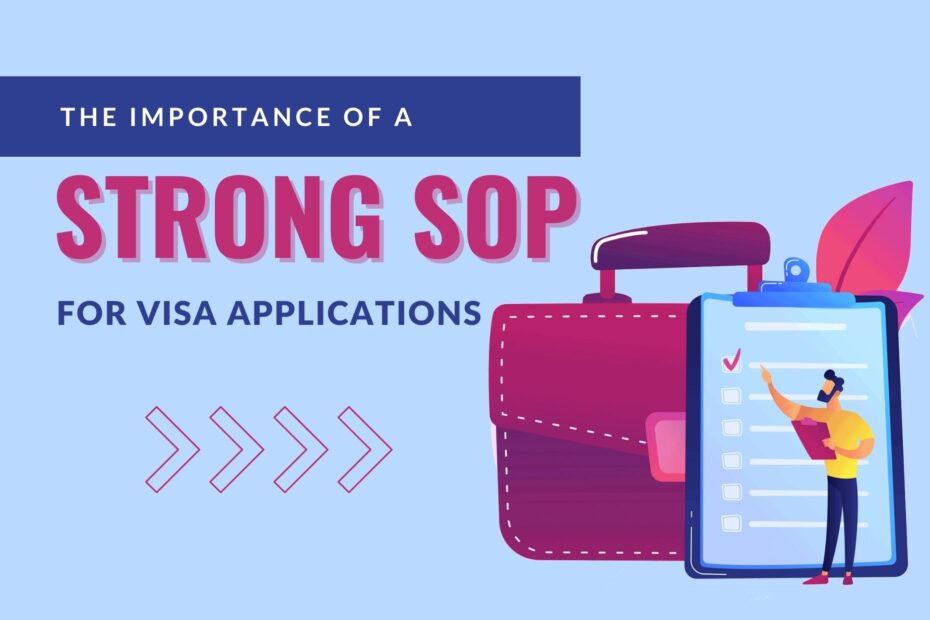If you’re planning a trip abroad, you know that getting a visa can be a daunting task. One essential part of the visa application process for many countries is the Statement of Purpose (SOP).
Now, you might be asking yourself, what is an SOP? Well, it’s a document that outlines your intentions for visiting the country and why you’re the perfect fit for a visa. A well-crafted SOP can have a significant impact on the success of your visa application. It gives the visa officer an inside look into who you are, where you come from, and what you plan to do in their country.
So, if you’re ready to tackle this important task, we’ve got you covered! In this article, we’ll give you a comprehensive guide on how to write a winning SOP for your visa application. We’ll cover everything from the essential components of a good SOP to tips for writing an effective one, dos and don’ts to keep in mind, and common mistakes to avoid.
By the end of this article, you’ll be equipped with all the knowledge you need to write a killer SOP that will get you one step closer to your dream destination. So, let’s dive in!
Components of a Winning SOP
If you’re applying for a visa, you know that a successful application requires a well-crafted Statement of Purpose (SOP). But what exactly should your SOP include? Let’s break it down.
First things first, a winning SOP should be clear, concise, and provide relevant information that demonstrates your eligibility and suitability for the visa. This means including the following components:
- Clear Introduction: Your introduction should grab the visa officer’s attention and provide a brief overview of your background and intentions for visiting the country. Be sure to state the purpose of the SOP and why you’re the perfect fit for the visa.
- Detailed Information about Yourself: This section should include personal details such as your name, address, contact information, and education history. It’s also crucial to highlight any relevant work experience, skills, or achievements that support your eligibility for the visa.
- Reasons for Visa Application: Clearly explain the specific reasons for your visa application, whether it’s for tourism, education, work, or family visit. This section should also detail your planned activities during your visit.
- Strong Ties to Home Country: To demonstrate your commitment to adhering to the visa conditions, it’s important to provide evidence of strong ties to your home country. This could be family, property, employment, or community involvement.
- Future Plans: Finally, provide details of your future plans after your visit, such as returning to your home country, pursuing further studies or employment, or starting a business.
By including these components in your SOP, you can demonstrate your eligibility, suitability, and commitment to following the visa conditions. But remember, it’s essential to tailor your SOP to the specific visa type and country requirements to increase your chances of success.
Tips for Writing a Winning SOP
If you’re planning to apply for a visa, you’ll need to nail your Statement of Purpose (SOP) to increase your chances of success. But don’t worry, with careful planning and attention to detail, you can write an SOP that will blow the visa officer away. Here are some tips to get you started:
First things first, research, research, research! You’ll want to dig deep and learn all about the country and institution you plan to visit. Understanding the local culture, customs, and values will help you tailor your SOP to the specific requirements and show that you’re a savvy traveler.
Avoid repeating yourself, The visa officer doesn’t want to read the same information over and over again. Make sure your SOP provides new and relevant information, such as your travel plans or the purpose of your visit.
Honesty is always the best policy. Be truthful and provide accurate information in your SOP. Fudging the facts or telling little white lies can lead to a rejected visa application – and nobody wants that.
Use simple language, The visa officer is a busy person, so make sure your SOP is easy to understand. Use clear and concise language to explain your intentions and plans.
And finally, make sure you follow the guidelines provided by the country for the visa application and the SOP. Don’t get tripped up by silly mistakes or overlook important details. Structure your SOP correctly and demonstrate your eligibility and suitability for the visa.
By following these tips, you’ll be well on your way to crafting a winning SOP and getting that coveted visa.
Dos and Don’ts of Writing SOP
When it comes to writing an SOP for a visa application, there are a few dos and don’ts that you need to keep in mind to make sure your SOP is effective and increases your chances of success.
Dos:
First things first, be clear and concise. Your SOP should be succinct and to the point, providing relevant information that shows the visa officer that you’re the perfect fit for the visa.
Focus on the specific purpose of your visit. Whether it’s for tourism, education, work, or family visit, make sure your SOP addresses the specific purpose of your visit. This demonstrates that you have a clear intention and plan for your travels.
Provide evidence to support your claims. If you’re highlighting work experience, education, or achievements, make sure you provide evidence to support those claims. This adds weight to your application and makes you stand out from the crowd.
Show strong ties to your home country. Make sure your SOP demonstrates your strong ties to your home country, whether it’s through family, property, employment, or community involvement. This shows the visa officer that you have no intention of overstaying or violating the visa conditions.
Proofread and edit your SOP. Make sure it’s free from errors and flows logically. The last thing you want is to have your application rejected because of a simple mistake.
Don’ts:
Don’t provide false or misleading information. Honesty is always the best policy, guys. Any false or misleading information provided in your SOP can lead to a rejected visa application.
Don’t be too generic. Make sure your SOP is tailored to the specific visa type and country requirements. A generic SOP that does not address specific requirements may be viewed negatively by the visa officer.
Don’t include irrelevant information. Stick to the relevant information that supports your eligibility and suitability for the visa. Anything else is just clutter.
Don’t write in an informal or casual tone. Keep it professional, guys. Your SOP should be written in a formal tone that reflects the seriousness of the visa application.
And finally, don’t exceed the word limit. Stick to the word limit provided by the country for the SOP. Trust me, the visa officer won’t appreciate a rambling essay.
Follow these dos and don’ts, and you’ll be well on your way to writing a winning SOP that gets you that visa.
Writing the SOP
When it comes to visa applications, the statement of purpose (SOP) can make all the difference. This document provides an overview of the applicant’s background, academic and professional achievements, and outlines the purpose of the visit. It’s a way for the visa officer to determine whether the applicant is a serious and legitimate candidate. That’s why writing a winning SOP is crucial.
To start, make sure you follow the specific requirements of the visa category you’re applying for. This means structuring the SOP in a clear and concise manner, so the reader can easily understand your intentions. Begin with a greeting and a brief summary of your background and purpose of the visit.
In the body of the SOP, focus on your academic and professional achievements and your plan to return home after the visit. Be specific about the activities you have planned during your visit, including the names of institutions, companies, or individuals you plan to meet. This will show the visa officer that you have a clear intention and plan for your visit.
In the conclusion, restate the purpose of your visit and express your gratitude. End on a positive note, demonstrating your enthusiasm and eagerness to pursue your goals. Once you’ve written your SOP, review and edit it thoroughly. Check for grammar and spelling errors, ensure that it meets the visa requirements, and get feedback from friends and family. Finally, make sure to save the SOP in the required format and submit it along with your visa application.
Useful resources: SOP for Canada Student Visa – SOP Format & Sample PDFs
Reviewing and Editing the SOP
Writing a winning SOP for a visa application is no easy feat, but it’s definitely possible with the right steps. And one of the most crucial steps is reviewing and editing the SOP.
To start, make sure to review the SOP for any grammar and spelling errors. You want your SOP to be polished and professional, so any mistakes can harm your chances of approval. Plus, it’s always a good idea to make sure that your writing is easy to understand.
Next, check that your SOP meets the requirements of the specific visa category. This is important because you want to make sure that you’re providing all the necessary information to show that you’re a suitable candidate. This could include information about your academic or professional background, your intentions to return home after your visit, and more.
Getting feedback from friends and family can also be helpful. They can provide a fresh perspective on your writing and point out any areas that need improvement. You want your SOP to be well-structured, easy to read, and concise, so their feedback can help you achieve that.
Finally, make any necessary edits to your SOP. This could include reorganizing the content or revising sentences to improve the flow of your writing. Remember, a well-written SOP can make a significant difference in the outcome of your visa application.
In conclusion, reviewing and editing your SOP is an essential step in the process of writing a winning SOP for a visa application. By taking the time to check for errors, ensure that the SOP meets the visa requirements, and getting feedback from others, you can produce an impressive SOP that showcases your credibility and intent, boosting your chances of obtaining a visa.
You may also like: The Importance of a Strong SOP for Visa Applications

Conclusion
Crafting a winning SOP for a visa application isn’t a walk in the park. It takes an eagle eye for detail, extensive research, and a concise and professional writing style. To stand out from the crowd, applicants need to follow the specific requirements for their visa category, organize their information effectively, and showcase their credibility and intentions to the visa officer.
But the job isn’t done yet. Once the SOP is written, it’s essential to give it a once-over to ensure it meets all the visa requirements and contains no errors. A polished SOP can significantly increase the chances of obtaining a visa, while a sloppy one can turn the tables against the applicant.
To produce a high-quality SOP, it’s critical to use a well-structured and clear document, with appropriate headings and subheadings. Reviewing and editing the SOP is the final step in producing a winning document. By following the tips and advice outlined in this article, applicants can put their best foot forward and increase their chances of obtaining a visa.
